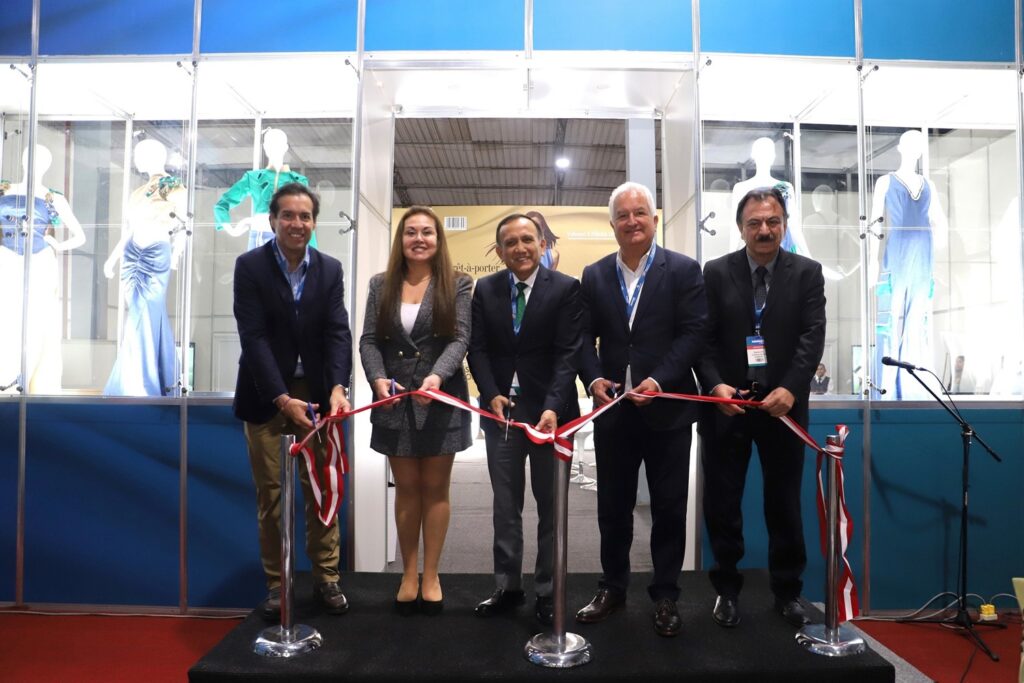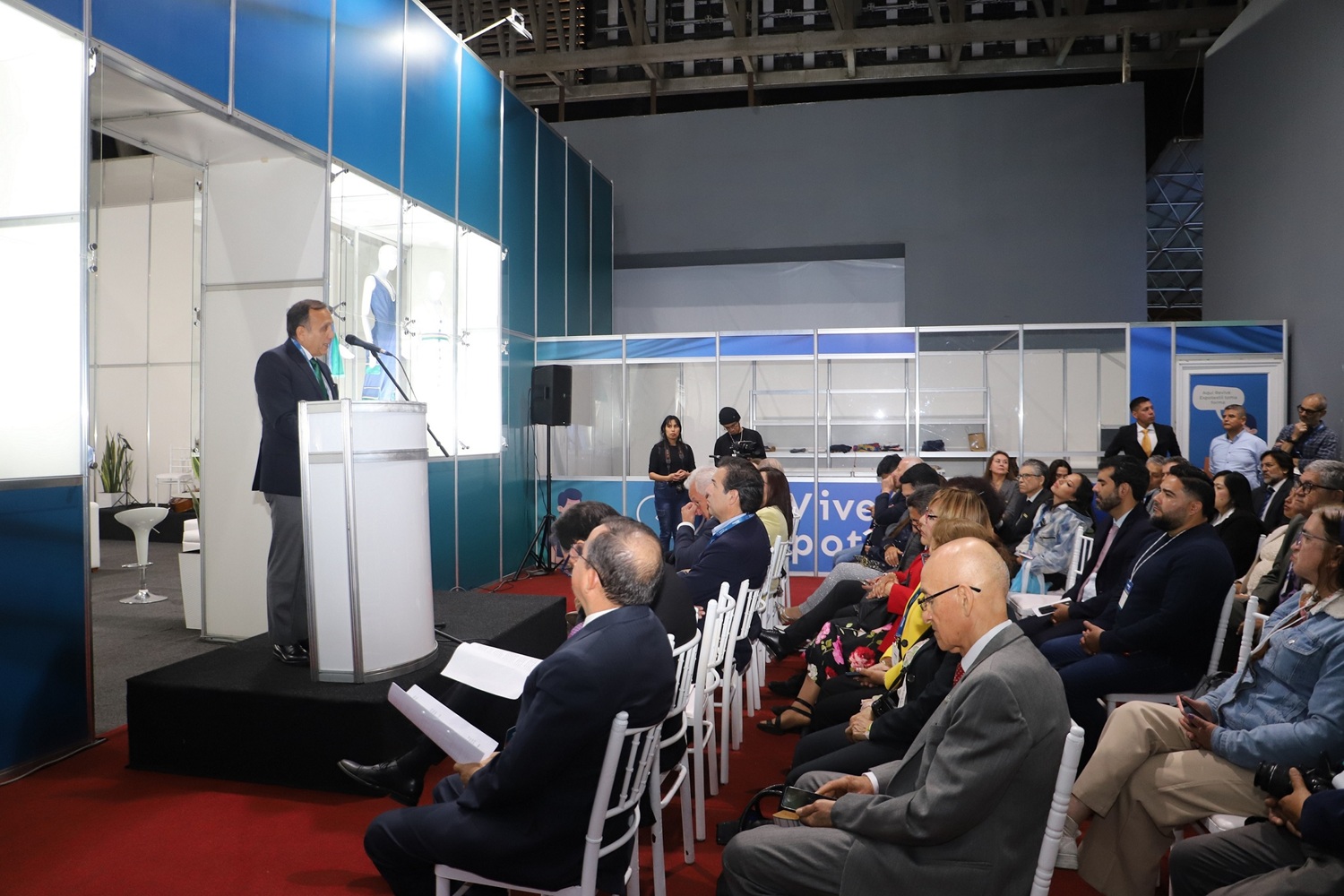Agencia Peruana de Noticias PRENSAPERU.PE https://www.prensaperu.pe Twitter: @prensaperupe En un contexto global y geopolítico marcado por cambios trascendentales que redefinen el comercio internacional, el próximo proceso electoral en el Perú se presenta como una coyuntura propicia para forjar consensos en torno a una agenda de desarrollo productivo. Esta agenda debe estar orientada a impulsar tanto el empleo formal como la competitividad, según lo destacó el presidente de la Asociación de Exportadores (ADEX), César Tello Ramírez, durante su intervención en Expotextil 2025.
Tello Ramírez resaltó la notable resiliencia de la cadena textil-confecciones frente a los desafíos actuales y enfatizó la necesidad de un esfuerzo conjunto para consolidar el sello ‘Made in Peru’ como un distintivo de calidad, diseño e innovación responsable. Este sello debe reflejar la creatividad y autenticidad intrínsecas de las prendas peruanas, diferenciándolas de las ofertas de otros competidores en el mercado global.
“El país requiere imperativamente estabilidad jurídica, instituciones sólidas, transparencia y seguridad ciudadana, elementos que constituyen pilares fundamentales para el sostenimiento de la inversión y la confianza empresarial. La industria textil, caracterizada por su intensidad en empleo y tecnología, necesita reglas claras y predecibles para poder planificar a largo plazo. No es viable tomar decisiones estratégicas cuando las normativas están sujetas a cambios con cada administración gubernamental o cuando la conflictividad social perturba los procesos productivos”, advirtió el presidente de ADEX.
Tello recordó que, aunque en 2008 las exportaciones de la cadena textil-confecciones alcanzaron un récord histórico de US$ 2 mil 100 millones, países como Vietnam, a pesar de ser más pequeños, han logrado superar estas cifras gracias a políticas industriales sólidas, exportando actualmente más de US$ 35 mil millones anuales. “La clave reside en la continuidad de las políticas y en la planificación estratégica a largo plazo”, puntualizó.
Subrayó además que las políticas públicas dirigidas al fomento productivo ejercen un impacto directo y significativo en las exportaciones. “Durante años, hemos promovido una legislación que fortalezca al sector textil, inspirándonos en el éxito de la Ley Agraria, que permitió que las agroexportaciones no tradicionales crecieran exponencialmente, pasando de US$ 400 millones en el año 2000 a más de US$ 11 mil 139 millones en 2024. Este es el tipo de visión de Estado que debemos replicar en otros sectores”, enfatizó.
Adicionalmente, Tello señaló que las tendencias globales actuales pueden favorecer al Perú si se adoptan estrategias adecuadas. “Hoy en día, la sostenibilidad y la innovación representan la verdadera ventaja competitiva. El consumidor global demanda materiales sostenibles, procesos de producción limpios, textiles inteligentes y trazabilidad total. El Perú tiene el potencial de consolidarse como un proveedor confiable, responsable y con un claro propósito”, afirmó.
En este contexto, instó a fortalecer las certificaciones ambientales y sociales, así como a incorporar tecnologías digitales como el blockchain para garantizar la transparencia y acelerar la transición hacia fuentes de energía limpias. “La sostenibilidad ya no es simplemente una tendencia, sino un requisito indispensable para acceder a los mercados más exigentes y de mayor valor”, añadió.
NEARSHORING COMO OPORTUNIDAD
Tello también destacó que la tendencia del nearshoring representa una oportunidad histórica para el Perú. Las grandes marcas están buscando diversificar su producción fuera de Asia y acercarla a mercados que ofrezcan seguridad, eficiencia y sostenibilidad. Consideró que el Perú cuenta con las condiciones necesarias para capitalizar esta reconfiguración, gracias a su ubicación estratégica, acuerdos comerciales vigentes, una sólida capacidad productiva y una reputación internacional de cumplimiento.
Tras mencionar que entre enero y agosto de 2025 las exportaciones de la cadena textil-confecciones crecieron un 7% en comparación con el mismo período de 2024, Tello precisó que detrás de estas cifras hay personas, familias y comunidades. “Este sector generó más de 90 mil empleos formales directos, y si consideramos los empleos indirectos e inducidos, esta cifra se eleva a más de 278 mil en todo el país”, destacó.
Este desempeño, concluyó, reafirma la necesidad de diversificar mercados, innovar en diseño, invertir en tecnología y fortalecer la trazabilidad de los procesos productivos. “Cada prenda que sale del Perú lleva consigo la calidad de nuestras fibras, el talento de nuestros trabajadores y el compromiso con un desarrollo inclusivo”, afirmó.
CONCLUSIONES
1.- Necesidad de Consensos y Estabilidad: El Perú debe aprovechar el proceso electoral para construir consensos en torno a una agenda de desarrollo productivo que impulse el empleo formal y la competitividad. La estabilidad jurídica, instituciones sólidas, transparencia y seguridad ciudadana son cruciales para atraer y sostener la inversión.
2.- Sostenibilidad e Innovación como Ventajas Competitivas: Para consolidarse como un proveedor confiable y responsable, el Perú debe enfocarse en la sostenibilidad y la innovación, respondiendo a la demanda global de materiales sustentables, procesos limpios y trazabilidad total.
3.- Oportunidad del Nearshoring: El nearshoring representa una oportunidad histórica para el Perú, que debe capitalizar su ubicación estratégica, acuerdos comerciales y capacidad productiva para atraer a grandes marcas que buscan diversificar su producción fuera de Asia.
Fuente: Agencia Peruana de Noticias PRENSAPERU.PE https://www.prensaperu.pe Twitter: @prensaperupe

English Translation
Textiles and Apparel: Resilience and Opportunities for ‘Made in Peru’ in the Global Market, the Seal that Peru Must Promote.
Peruvian News Agency PRENSAPERU.PE https://www.prensaperu.pe Twitter: @prensaperupe In a global and geopolitical context marked by momentous changes that are redefining international trade, the upcoming electoral process in Peru presents an opportune moment to forge consensus around a productive development agenda. This agenda should be geared towards boosting both formal employment and competitiveness, as highlighted by the president of the Association of Exporters (ADEX), César Tello Ramírez, during his address at Expotextil 2025.
Tello Ramírez emphasized the remarkable resilience of the textile and apparel supply chain in the face of current challenges and stressed the need for a joint effort to consolidate the ‘Made in Peru’ seal as a hallmark of quality, design, and responsible innovation. This seal should reflect the intrinsic creativity and authenticity of Peruvian garments, differentiating them from the offerings of other competitors in the global market.
“The country urgently needs legal stability, strong institutions, transparency, and citizen security—elements that are fundamental pillars for sustaining investment and business confidence. The textile industry, characterized by its labor and technology intensity, needs clear and predictable rules to be able to plan for the long term. It is not viable to make strategic decisions when regulations are subject to change with each new government administration or when social conflict disrupts production processes,” warned the president of ADEX.
Tello noted that, although in 2008 textile and apparel exports reached a record high of US$2.1 billion, countries like Vietnam, despite being smaller, have managed to surpass these figures thanks to sound industrial policies, currently exporting more than US$35 billion annually. “The key lies in the continuity of policies and long-term strategic planning,” he emphasized.
He further emphasized that public policies aimed at boosting production have a direct and significant impact on exports. “For years, we have promoted legislation to strengthen the textile sector, drawing inspiration from the success of the Agrarian Law, which allowed non-traditional agricultural exports to grow exponentially, from US$400 million in 2000 to more than US$11.139 billion in 2024. This is the kind of vision we should replicate in other sectors,” he stressed.
Additionally, Tello pointed out that current global trends can benefit Peru if appropriate strategies are adopted. “Today, sustainability and innovation represent the true competitive advantage. The global consumer demands sustainable materials, clean production processes, smart textiles, and full traceability. Peru has the potential to consolidate itself as a reliable, responsible supplier with a clear purpose,” he stated.
In this context, he urged the strengthening of environmental and social certifications, as well as the incorporation of digital technologies such as blockchain to guarantee transparency and accelerate the transition to clean energy sources. “Sustainability is no longer simply a trend, but an indispensable requirement for accessing the most demanding and highest-value markets,” he added.
NEARSHORING AS AN OPPORTUNITY
Tello also highlighted that the nearshoring trend represents a historic opportunity for Peru. Major brands are seeking to diversify their production outside of Asia and bring it closer to markets that offer security, efficiency, and sustainability. He considered that Peru has the necessary conditions to capitalize on this reconfiguration, thanks to its strategic location, existing trade agreements, solid production capacity, and an international reputation for compliance.
After mentioning that between January and August 2025, exports from the textile and apparel sector grew by 7% compared to the same period in 2024, Tello emphasized that behind these figures are people, families, and communities. “This sector generated more than 90,000 direct formal jobs, and if we consider indirect and induced jobs, this figure rises to more than 278,000 nationwide,” he highlighted.
This performance, he concluded, reaffirms the need to diversify markets, innovate in design, invest in technology, and strengthen the traceability of production processes. “Every garment that leaves Peru carries with it the quality of our fibers, the talent of our workers, and a commitment to inclusive development,” he stated.
CONCLUSIONS
1.- Need for Consensus and Stability: Peru must take advantage of the electoral process to build consensus around a productive development agenda that promotes formal employment and competitiveness. Legal stability, strong institutions, transparency, and citizen security are crucial to attracting and sustaining investment.
2.- Sustainability and Innovation as Competitive Advantages: To consolidate its position as a reliable and responsible supplier, Peru must focus on sustainability and innovation, responding to the global demand for sustainable materials, clean processes, and full traceability.
3.- Nearshoring Opportunity: Nearshoring represents a historic opportunity for Peru, which must capitalize on its strategic location, trade agreements, and production capacity to attract major brands seeking to diversify their production beyond Asia.
Source: Peruvian News Agency PRENSAPERU.PE https://www.prensaperu.pe Twitter: @prensaperupe
